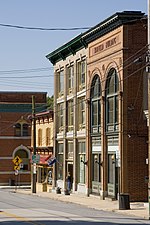Salopha (Sykesville, Maryland)
1718 establishments in the Thirteen ColoniesAll Wikipedia neutral point of view disputesGothic Revival architecture in MarylandHouses completed in 1718Houses in Howard County, Maryland ... and 5 more
Howard County, Maryland landmarksLog buildings and structures in the United StatesPlantation houses in MarylandSykesville, MarylandWikipedia neutral point of view disputes from August 2019
Salopha or Solopha is a historic plantation house located in Sykesville, Howard County, Maryland.Salopha is a historic house, farm and bank barn. The farm house is built around a log house constructed in 1718 that predates the land grant patented to John Johnson in September 18, 1742. In 1762 Vachel Dorsey expanded the structure. The property was purchased in 1829 by Charles Alexander Warfield for $2,400 (~$74,723 in 2022). In 1889 the house was modified in a Gothic revival style. The home is the birthplace of former Carroll County commissioner Joshua Warfield Dorsey Sr. The bank barn built by the Warfield brothers in 1889 burned in 1972.
Excerpt from the Wikipedia article Salopha (Sykesville, Maryland) (License: CC BY-SA 3.0, Authors).Salopha (Sykesville, Maryland)
River Road,
Geographical coordinates (GPS) Address Nearby Places Show on map
Geographical coordinates (GPS)
| Latitude | Longitude |
|---|---|
| N 39.352777777778 ° | E -76.945833333333 ° |
Address
River Road 736
21784
Maryland, United States
Open on Google Maps










